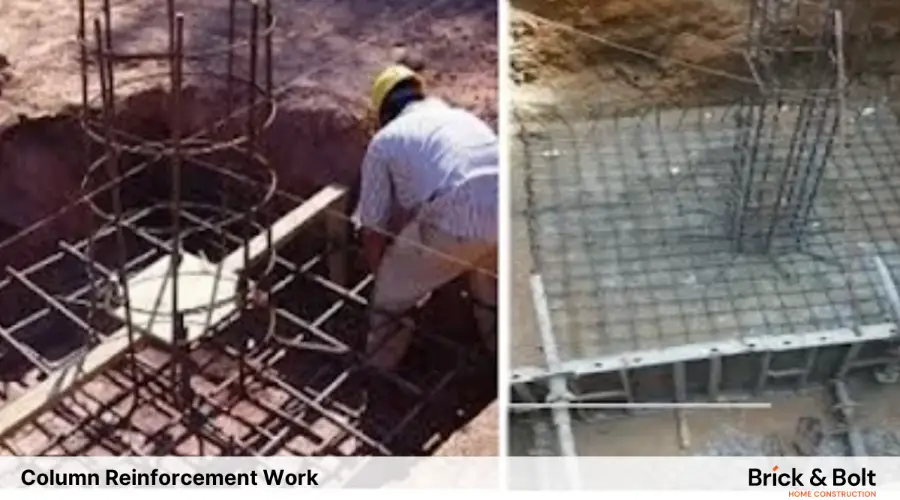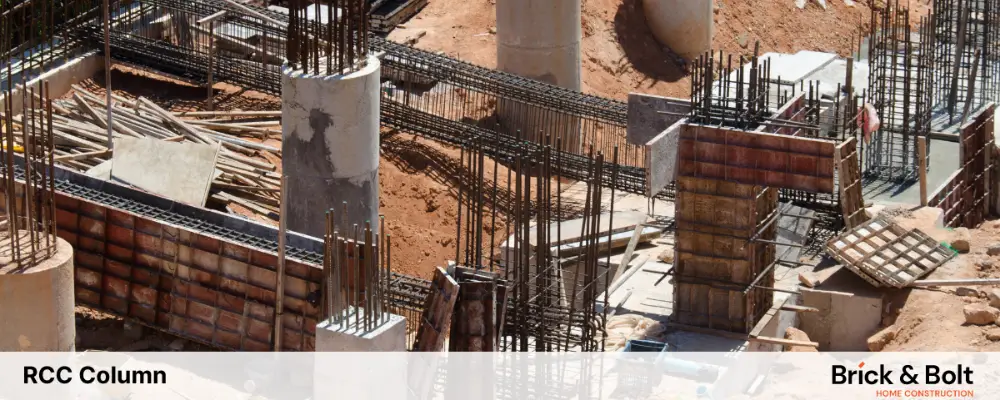Reinforced cement concrete columns are an important element used in construction. They provide structural stability and load-bearing capacity for the buildings. By understanding different types of reinforced cement concrete columns, their shapes, lengths, and methods of construction can help in providing efficient and safe building designs.
What is the RCC Column?
The RCC column is a vertical structure that is designed for carrying compressive loads. It is mainly made up of reinforced concrete with steel bars. This helps improve strength and durability. The RCC column will support the loads from the beams, roofs, and floors while distributing the weight to the foundation.
The RCC columns have two purposes in the construction, as they can act as a load-bearing element as well as provide lateral stability. These columns can differ in their shape, size, and design. This mainly depends upon the load that they are expected to carry on the requirements of the building.
Types of RCC columns
| Name | Types | Composition | Manufacturing | Application |
| RCC Columns Based on Shapes | ||||
| Circular | Concrete reinforced with steel bars | Manufactured on-site or as precast units; circular formwork is used | Used in high-rise buildings, bridges, towers; architectural designs | |
| Square/Rectangular | Concrete with steel reinforcement | Easier construction due to straight formwork | Residential and commercial buildings; easier alignment with walls | |
| RCC Columns Based on Length | ||||
| Short Column | Concrete with steel, L/B ≤ 12 | Designed to avoid buckling; requires standard reinforcement techniques | Used in low-rise buildings where floor height is approx. 3m or less | |
| Long Column | Concrete with steel, L/B > 12 | Requires additional reinforcement to prevent buckling; slender columns | Common in high-rise buildings and towers where floor height exceeds 3m | |
| RCC Columns Based on Moments | ||||
| Biaxial Column | Reinforced concrete; axial load & moment in 2 directions | Additional steel reinforcement to handle stresses from multiple directions | Used in corner columns of buildings to manage forces from multiple directions | |
| Uniaxial Column | Reinforced concrete; axial load & moment in 1 direction | Simpler reinforcement compared to biaxial columns | Used in side or internal columns where loads act predominantly along 1 axis | |
Types of RCC Columns Based on Shapes
Circular Columns
Circular columns are commonly used in the areas where they will be exposed to lateral forces while also maintaining aesthetic appeal. These columns can be seen in bridges, towers, and high-rise buildings, as a circular shape can be more effective at resisting the load from multiple directions.
Square or Rectangular Columns
The square rectangle columns are normally adapted for various structures. They are used in conventional construction. The rectangular or square shape makes them easier to construct and economically feasible compared to circular columns. These columns can be seen in residential buildings and commercial buildings because they can align with the walls easily.
RCC Column Types Based on Length
Short Column
A short column has the column length less than or equal to 12 times the least lateral dimension. The columns are normally stronger as they are less susceptible to buckling under the load. Short columns are normally used in low-rise buildings where the large loads are concentrated in a small area.
Long Column
Long columns have a column that is more than 12 times the least lateral dimension. These columns are affected by buckling, and they need additional reinforcement for prevention of failure. These columns are normally used in towers and high-rise buildings where the height is necessary. Long columns can generate more forces, so they must be designed with caution.
Types of RCC Columns Based on Moments
Biaxial Column
Biaxial columns are mainly subjected to bending moments about both perpendicular axes. Biaxial columns are commonly used in areas subjected to loads from multiple directions, such as corner columns of buildings.. The reinforcement in biaxial columns is designed carefully for handling the stress from both directions. This will help in ensuring the stability and their different loads.
Uniaxial Columns
Uniaxial columns are mainly subjected to the bending moments in one axis. These columns are normally used in the areas where loads act along one axis, like interior columns in a building. Uniaxial column reinforcement is simple compared to that of biaxial columns, as it needs to resist the force from one direction. However, axial loads are still resisted, and shear forces may need to be considered depending on the design.
Construction Methods of RCC Columns
There are mainly four stages of construction used in RCC columns; they are,
- Column layout work.
- Column reinforcement work.
- Column Formwork and
- Pouring Concrete
Column Layouts
This is the first step in the construction of columns. In this step, the column location will be decided practically in the field. Here the ropes will be laid out in the gridlines, and the location of columns will be marked.
Column Reinforcement Work
When marking the location of the column is completed, the reinforcement column will be placed based on the structural drawing.
Example 1:
C1-12#16 mm and stirrup-10 mm@4″c/c
Here the column has 12 vertical steelbars, and each of them has a 16 mm diameter. This is supported by stirrups made of a steel bar of 10 mm diameter. These stirrups will be placed at a distance of 4 inches apart from each other.
Example 2:
C2-8#20 mmØ + 10#16 mmØ and stirrup-10 mmØ@(4+6″)c/c
This means column C2 will have:
- 8 vertical bars, each with a 20 mm diameter, and
- 10 vertical bars, each with a 16 mm diameter.
The stirrups (10 mm diameter steel) will be spaced as follows:
- In the middle half of the column’s height, the stirrups will be placed 6 inches apart.
- In the top quarter and bottom quarter of the column’s height, the stirrups will be spaced 4 inches apart.

Column reinforcement works must follow some checklists on the site. That are,
- The numbers and diameter of the vertical bars must be checked.
- Vertical bars space
- Development length must be checked as it depends upon the bar diameter.
- Lapping in an alternate bar must come at a similar height.
- And lapping must not come inside the beam or a slab.
- As per the structural notes, the lapping must be 1/3 or 2/3 the column.
- The spaces between must follow the drawing.
- Hooks must be properly bent at right angles.
- Check the corner of the stirrups. The vertical bar must come at the right angle of the edge to properly bind to the binding wire.
Column Formwork
Columns will carry a load of structure, and they can be critical. It is important to align the columns vertically so that the load will be transmitted properly. The column shuttering must be strong enough to undertake the pressure of fresh concrete and also must remain in position during concreting.
The height of the floor is normally kept at 10 feet. If the slab has been kept, then the concrete has to be poured on the beam’s bottom level. For instance, if the height of the beam given in the drawing is 1′-6″, then the casting height for column formwork will be 8′-6″.
You must understand that dropping concrete more than 5 feet high is not allowed because it creates segregation. Since it is necessary to create the formwork within 5 feet height. Once the first part is completed in casting, then the rest of the part will start.
Guidelines on column shuttering
- For holding the concrete shuttering in place and for the correct alignment, the concrete pad called starter is cast. The starter pad will be cast before fixing the suttering. The thickness will be around 45 mm to 60 mm, and the dimensions will be correct as proposed in the dimensions of the column. Also, the starter pad must be cured for a day or two so that it can be hard enough for fixing the shuttering around it.
- Column shuttering is made from plywood sheets or steel sheets that are fabricated along with adequate stiffeners.
- To the inner surface, thin films of oil or grease must be applied that can help in easy removal of columns after the hardening of concrete.
- The alignment of the shuttering must be proper in vertical and diagonal directions, as it can ensure the accuracy of the dimension.
- Formwork has to be completely supported with the proper size before pouring into the concrete. This is because it must not move horizontally or vertically during the concreting process.
- Gaps present near the shuttered joints must be sealed by using plaster or wood for prevention of any slurry leakage.
- The preferred time to remove shutters is after 24 hours of casting, and if they are in need to be removed earlier, Then it must not be removed within 16 hours.
- The shutters must be removed gently without any jerkings so that the column edges will not be damaged.
- Regarding the fixing and support of column shuttering. Care must be taken for prevention of movement during concreting.
- For dimensional accuracy, the diagonals of the shuttering must be checked.
Pouring of Concrete
The concrete pouring is the last step of column construction. They can be completed in two different methods, namely manual and by using a machine or pump.
Steps that must be followed during and after concreting
- Machine-mixed concrete can be used for less quantity, and ready-mix concrete must be ordered for a larger quantity.
- You must ask the client for approval regarding placement of concrete by pump or manual.
- The concrete must be poured down to the bottom slab. Then the remaining column can get concreted during slab and beam pouring.
- Mechanical vibrators can be used in the column, but excess vibration can lead to segregation. So each layer must be properly compacted.
- The target slump can be 160 mm, and the height of pouring the concrete must not be more than 1.5 meters.
- Joint construction must be avoided for columns.
- Proper cover according to the structural drawings must be maintained.
- While boring the concrete, the temperature must be below 30 degrees.
- After pouring the concrete and vibrating it with the help of a vibrator, the horizontality and verticality of the column must be checked.
Conclusion
The most fundamental element used in the construction is the RCC column, as it can provide strength and durability to the buildings. RCC columns can be used in various forms for supporting the loads and resisting the external forces. They also provide structural integrity to the building.
FAQs
The size of the RCC column normally differs depending upon the loads that it needs to carry and the structural design. Some of the common senses for residential and commercial buildings will range from 230 mm x 230 mm to 450 mm x 450 mm.
The grade for the concrete used in the RCC columns usually ranges from M20 to M30. This mainly depends upon the requirements of the structure. Higher grades can be used in high-rise buildings.
For calculating the column weight of RCC, first weigh the column volume and calculate the concrete weight. Then calculate the steel reinforcement weight and at the end, calculate the total weight of the column.

